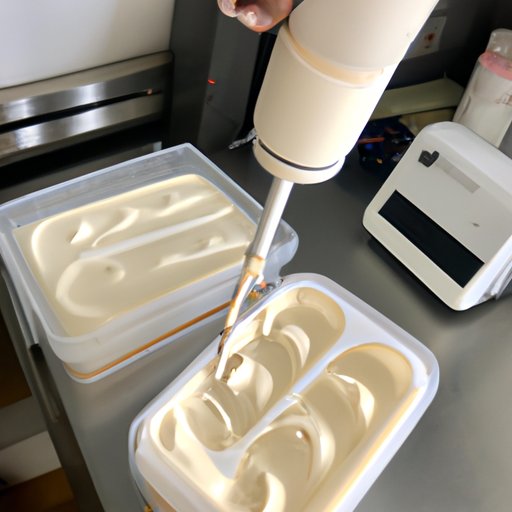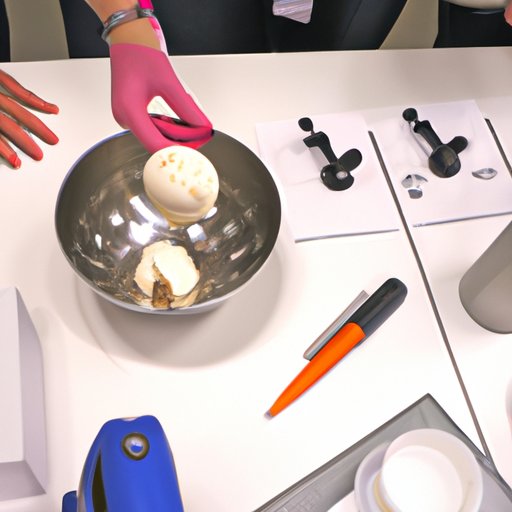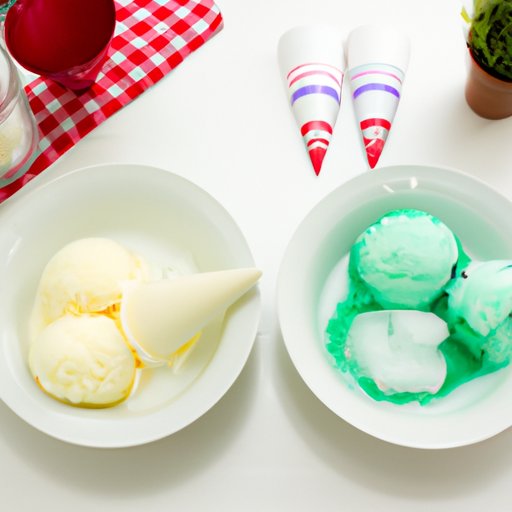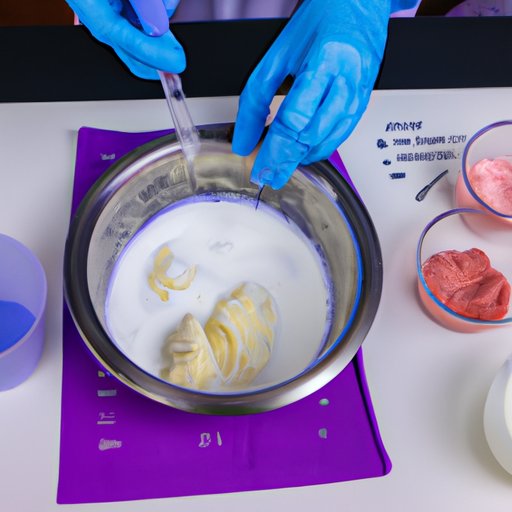Introduction
Ice cream is one of the most beloved treats in the world. It’s also a great way to learn about science! Making ice cream requires an understanding of many different scientific principles, including heat transfer, freezing point depression, and chemical reactions. This article provides a step-by-step guide to making ice cream using science, exploring the physics and chemistry involved, and offering fun experiments for kids.
Step-by-Step Guide to Making Ice Cream Using Science
Making ice cream at home can be a fun and educational experience. The following steps will walk you through the process of creating your own delicious treat.
Explaining the Process
The basic process of making ice cream involves combining ingredients, such as milk, sugar, and flavorings, and then churning them together in an ice cream maker. As the mixture is churned, it is cooled by a combination of cold air and salt, which lowers its temperature until it reaches the desired consistency.
Listing Necessary Materials
To make ice cream at home, you will need the following materials:
- Milk
- Sugar
- Salt
- Ice
- Ice cream maker
- Flavorings (optional)
Demonstrating the Procedure
Once you have gathered all the necessary materials, you can begin the process of making your ice cream. Here are the steps:
- Combine the milk, sugar, and flavorings in a bowl and mix them together until they are fully incorporated.
- Pour the mixture into the ice cream maker and turn it on.
- Add the ice and salt to the outside of the machine, making sure that the ice is evenly distributed around the sides.
- Churn the mixture for 20-30 minutes, or until it reaches the desired consistency.
- Transfer the ice cream to a container and place it in the freezer to firm up before serving.

Exploring the Physics Behind Homemade Ice Cream
Making ice cream is a great way to explore the physics behind food preparation. Here are some key concepts to keep in mind when making your own homemade ice cream.
Describing How Heat Transfers Affect Ice Cream Making
Heat transfer plays an important role in the making of ice cream. As the mixture is churned, the heat from the liquid is transferred to the colder surrounding environment, resulting in a decrease in temperature. This process is known as “heat exchange” and is essential for achieving the desired texture and consistency of the final product.
Explaining the Role of Freezing Point Depression
Freezing point depression is another key concept in ice cream making. When salt is added to the ice and water mixture, it lowers the freezing point of the liquid. This process is known as “freezing point depression” and helps to ensure that the ice cream mixture reaches the desired consistency.
Examining the Impact of Pressure on Ice Cream
Pressure is also an important factor in ice cream making. As the mixture is churned, the pressure inside the machine increases, resulting in a more homogenous product. According to a study published in the Journal of Food Engineering, “an increase in pressure is associated with an increase in the rate of heat transfer, thus resulting in a faster cooling of the ice cream mix.”
Engineering Your Own Delicious Ice Cream Experiment
Once you understand the basics of ice cream making, you can start to experiment with different flavors and mix-ins. Here are some tips to help you create your own unique treat.
Identifying Different Flavors and Mix-Ins
When making your own ice cream, you can choose from a wide variety of flavors and mix-ins. Popular options include chocolate, strawberry, vanilla, and mint, as well as nuts, candy, and fruit. You can also experiment with different combinations to create your own signature flavor.
Choosing the Right Container for the Experiment
The type of container you use for your ice cream experiment is also important. Plastic containers are a popular choice, as they are lightweight and easy to clean. However, stainless steel containers are also a good option, as they are durable and will not absorb odors or flavors.
Deciding on the Best Ice Cream Machine
Finally, you’ll need to choose an ice cream machine for your experiment. There are several types available, including manual crank machines, electric machines, and self-contained machines. Each type has its own advantages and disadvantages, so be sure to research the options before making a purchase.
How Chemistry Can Help You Make the Perfect Ice Cream
In addition to physics, chemistry plays an important role in ice cream making. Here are some key concepts to keep in mind when crafting your own delicious treat.
Explaining the Chemical Reactions Involved in Ice Cream Making
When making ice cream, several chemical reactions take place. These reactions involve the breakdown of proteins, fats, and carbohydrates, as well as the formation of new compounds. For example, as the ice cream mixture is churned, the fat molecules break down and form new compounds known as “emulsifiers”, which help to keep the ice cream smooth and creamy.
Understanding the Chemistry of Flavoring Agents
Flavoring agents, such as chocolate, vanilla, and other extracts, also play an important role in ice cream making. These compounds are composed of molecules that interact with each other in complex ways, resulting in the characteristic flavor and aroma of the finished product.
Analyzing the Role of Emulsifiers and Stabilizers
Emulsifiers and stabilizers are also important components of ice cream. These compounds help to keep the mixture from separating and provide structure to the final product. Common emulsifiers and stabilizers include lecithin, guar gum, xanthan gum, and carrageenan.
Crafting Ice Cream with Science: A Beginner’s Guide
Crafting ice cream with science can be a fun and educational experience. Here are some tips to help you get started.
Introducing Basic Concepts of Ice Cream Science
Before you start experimenting with ice cream recipes, it’s important to understand the basic concepts of ice cream science, such as heat transfer, freezing point depression, and chemical reactions. Once you have a solid understanding of these concepts, you’ll be ready to start crafting your own delicious creations.
Exploring Different Ice Cream Formulations
When crafting your own ice cream, you can experiment with different formulations, such as low-fat, no-sugar, and vegan recipes. Understanding the science behind each formulation will help you create the perfect treat for any occasion.
Utilizing Kitchen Tools to Create Unique Treats
You can also use kitchen tools, such as ice cream makers and mixers, to craft your own unique treats. With a little practice, you’ll be able to create delicious ice cream concoctions that are sure to impress your friends and family.

The Science of Ice Cream Making: An Interactive Tutorial
If you’re looking for a fun and interactive way to learn about the science of ice cream making, there are plenty of online tutorials available. These tutorials offer step-by-step instructions for making ice cream, as well as tips and tricks to improve your results.
Showcasing Popular Ice Cream Recipes
Many online tutorials feature popular ice cream recipes, as well as variations on classic favorites. This allows you to explore different flavor combinations and create your own unique treats.
Presenting Fun Experiments to Try at Home
Interactive tutorials also feature fun experiments to try at home. These experiments offer a hands-on approach to learning about the science of ice cream making, allowing you to explore different techniques and create delicious treats.
Offering Tips and Tricks to Improve Results
Finally, interactive tutorials offer tips and tricks to help you improve your results. From choosing the right ingredients to mastering techniques, these tutorials provide valuable advice that will help you become a master ice cream maker.

Fun and Educational Ice Cream Experiments for Kids
Making ice cream is a great way to teach kids about science. Here are some fun experiments that will help introduce them to the basics of ice cream science.
Introducing Basic Ice Cream Science Concepts
Simple experiments, such as making ice cream in a bag, can be used to introduce kids to the basic concepts of ice cream science, such as heat transfer and freezing point depression. These experiments are easy to do and provide a fun, hands-on way for kids to learn about the science behind their favorite treat.
Presenting Interesting Experiments for Kids
For kids who are interested in exploring more advanced concepts, there are several interesting experiments they can try. These experiments can teach kids about the chemistry of flavoring agents, the role of emulsifiers and stabilizers, and how pressure affects the texture of ice cream.
Offering Ideas for Creative Projects
Finally, you can encourage kids to use their creativity when making ice cream. Suggesting ideas for creative projects, such as creating unique flavor combinations or designing their own ice cream packaging, can help spark their imaginations and provide a fun learning experience.
Conclusion
Making ice cream with science can be a fun and educational experience. From understanding the physics and chemistry behind the process to exploring different flavors and mix-ins, this activity offers a unique way to learn about science. We hope this article has given you the tools you need to get started on your own homemade ice cream experiments!
Encourage further exploration by trying out different recipes and experimenting with different flavors and mix-ins.
(Note: Is this article not meeting your expectations? Do you have knowledge or insights to share? Unlock new opportunities and expand your reach by joining our authors team. Click Registration to join us and share your expertise with our readers.)
